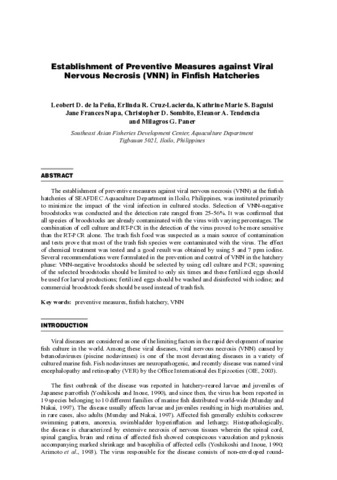Immunization regimen in Asian sea bass (Lates calcarifer) broodfish: A practical strategy to control vertical transmission of nervous necrosis virus during seed production
- Global styles
- MLA
- Vancouver
- Elsevier - Harvard
- APA
- Help

View/
Date
2018-08Author
Page views
2,094ASFA keyword
AGROVOC keyword
Taxonomic term
Metadata
Show full item record
Share
Abstract
Outbreaks of viral nervous necrosis (VNN) in Asian sea bass (Lates calcarifer) at the larval stages via vertical transmission of nervous necrosis virus (NNV) from asymptomatic broodfish remain as a major deterrent during seed production. A five-year study was conducted to produce NNV-specific-free sea bass broodfish reared in land-based tanks through an annual immunization regimen with the formalin-inactivated NNV. We primarily immunized (intraperitoneal injection) sea bass juveniles (5 g) and monitored the neutralizing antibody (Nab) titers in the sera of these fish at scheduled intervals post-immunization. Nab titers in the sera of immunized fish peaked at Month 2 (titer: 1:4480 ± 1185) but thereafter gradually declined and significantly dropped (1:260 ± 83) at Month 12 post-primary immunization. Booster immunization of these fish at Month 12 post-immunization led to abrupt increases in Nab titers in booster immunized (B-Im) fish at Month 1 (1:12800 ± 6704) but thereafter declined and dropped at Month 12 (1:480 ± 165) post-booster immunization. The annual booster injections with the inactivated vaccine or L-15 (Unimmunized [U-Im]) were consecutively conducted for 4 years until the fish became sexually mature. Mature fish from both groups were successively induced to spawn twice (1-month interval) via intramuscular injection with luteinizing hormone-releasing hormone analogue (LHRH-a; 100 µg/kg BW). NNV was not detected by RT-PCR in oocytes and milts, and spawned eggs of B-Im fish. In contrast, oocytes and milts, and spawned eggs of U-Im fish were NNV positive. Spawned eggs of B-Im broodfish exhibited Nab titers ranging from 1:192 ± 34 to 1:240 while such was not detected (<1:40) in eggs of U-Im fish. Taken together, current data clearly demonstrate that annual immunization regimen with inactivated NNV vaccine is a pragmatic approach for sustaining immunocompetent sea bass broodfish reared in land-based tanks and circumvent the risk of vertical transmission of NNV from asymptomatic broodfish to their offspring under stress of repetitive spawning.
Suggested Citation
Pakingking, R. V., Jr., de Jesus-Ayson, E. G., Reyes, O., & Bautista, N. B. (2018). Immunization regimen in Asian sea bass (Lates calcarifer) broodfish: A practical strategy to control vertical transmission of nervous necrosis virus during seed production. Vaccine , 36(33), 5002-5009. https://doi.org/10.1016/j.vaccine.2018.07.015
Type
ArticleISSN
0264-410XCollections
- Journal Articles [1258]
Related items
Showing items related by title, author, creator and subject.
-
Mass mortalities associated with viral nervous necrosis in hatchery-reared sea bass Lates calcarifer in the Philippines
Maeno, Yukio; de la Peña, Leobert D.; Cruz-Lacierda, Erlinda R. (Ministry of Tropical Agricultural Research Centre, 2004)Viral nervous necrosis (VNN), also known as viral encephalopathy and retinopathy (VER), is an emerging disease affecting larvae and juveniles of many farmed marine fish species in Asia, Australia, Europe and North America. ... -
Immunolocalisation of nervous necrosis virus indicates vertical transmission in hatchery produced Asian sea bass (Lates calcarifer Bloch)—A case study
Azad, I. S.; Jithendran, K. P.; Shekhar, M. S.; Thirunavukkarasu, A. R.; de la Pena, L. D. (Elsevier, 2006)A probable vertical mode of piscine nodavirus transmission is reported in the present investigation based on a case of nodavirus associated larval mortalities in hatchery produced Asian sea bass. Polyclonal rabbit anti-SJNNV ... -
Establishment of preventive measures against viral nervous necrosis (VNN) in finfish hatcheries
de la Peña, Leobert D.; Cruz-Lacierda, Erlinda R.; Baguisi, Kathrine Marie S.; Napa, Jane Frances; Sombito, Christopher D.; Tendencia, Eleonor ; Paner, Milagros G. (Aquaculture Department, Southeast Asian Fisheries Development Center, 2005-03)
The establishment of preventive measures against viral nervous necrosis (VNN) at the finfish hatcheries of SEAFDEC Aquaculture Department in Iloilo, Philippines, was instituted primarily to minimize the impact of the viral ...
; Paner, Milagros G. (Aquaculture Department, Southeast Asian Fisheries Development Center, 2005-03)
The establishment of preventive measures against viral nervous necrosis (VNN) at the finfish hatcheries of SEAFDEC Aquaculture Department in Iloilo, Philippines, was instituted primarily to minimize the impact of the viral ...





